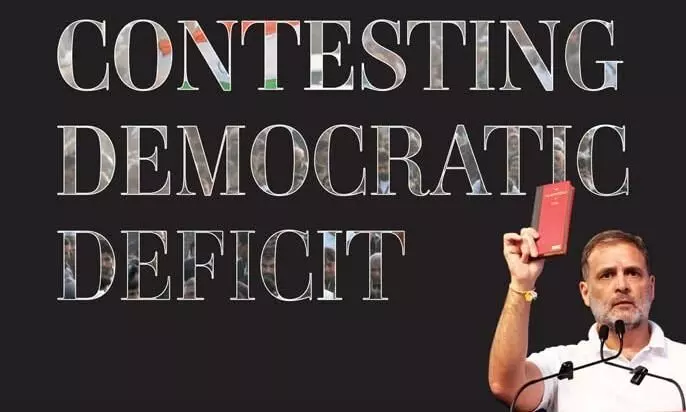A Chronicle of Resistance and Revival
In Contesting Democratic Deficit, Salman Khurshid & Mritunjay Singh Yadav analyse India’s 2024 electoral battle, which was essentially a fight to reclaim democracy from the grip of centralisation, polarisation, and fading constitutional hope. Excerpts:

After an in-depth analysis by our war room, we were confident of winning around 110–120 seats. However, the exit poll results on 1 June belied all reports from the field, which had progressively tilted in favour of the INDIA Alliance. All the polls universally gave the BJP a runaway victory. They forecast that the BJP and its allies would win more than 350 seats in the Lok Sabha, prompting Congress leaders to express reservations about the reliability of the projections.
Our alliance partners put up a brave face, and the usual responses about such polls being often unreliable were given out. But there were worries given the recent questions about voter data. However, we found some reassurance in the assessments of seasoned pollsters like Yogendra Yadav, along with independent journalists like Mahesh Choudhary and alternative media outlets, who predicted that the BJP’s seat count would be in a more modest range of 220–230. Unverified reports claimed that several exit polls were supposedly moderated under the ruling party’s ‘advise’. Inevitably, speculation began about an advance coverup for a manipulated result in favour of the government.
Fortunately, all these fears turned out to be unwarranted because it was another story once the results hit the television channels on 4 June. The BJP did not win a majority, but it emerged as the largest single party, winning 240 seats. The BJP-led NDA (with the JD[U] and the TDP, two slippery partners) won 293 seats, enough to be invited to form the government. Within the INDIA bloc, the Congress led with 99 of the 328 seats it contested and became the cutting edge of the alliance. With these numbers, the Congress was all set to claim the position of Leader of Opposition (LoP) in the Lok Sabha.
In retrospect, I wonder how so many pollsters could have been wrong. (See table)
Following the election results, India’s wildly inaccurate exit polls sparked dramatic public apologies from polling companies and calls for investigation into possible manipulation. These polls had pushed the benchmark equity index to a record high on 3 June, followed by a crash a day later when almost $400 billion (Rs 3,336,284 crore) in value was wiped off the market. Opposition parties called on the country’s stock market regulator and Parliament to investigate polling companies and BJP leaders for possible rigging. Rahul Gandhi insisted that people high up in the BJP had carried out a scam and demanded to know whether these polls were actually carried out, their methodology, and the details of the investors.
Message from the States: Decoding the Results
Rahul Gandhi’s tireless campaign in the name of the Constitution and in the face of the threat to reverse reservations, as well as the uncompromising demand for a caste census, ensured that out of the 84 reserved SC seats in the country, we won twenty compared to six in 2019. The BJP’s number went down to 30 from 46 in 2019. The INDIA Alliance notably increased its SC vote share, from 28 per cent in the 2019 elections to 46 per cent in 2024.
Muslims constitute 14 per cent of India’s population. The Congress saw an increase in its Muslim vote share from 33 per cent to 38 per cent. This five per cent gain reflects the party’s efforts to rebuild trust and reconnect with Muslim voters. Even more striking is the performance of the INDIA Alliance, which saw its Muslim vote percentage surge to 42 per cent, a significant increase from the 19 per cent it secured in 2019. This 23 per cent increase suggests a robust consolidation of Muslim votes towards the INDIA Alliance. Parties that were not part of INDIA or NDA, like the BSP, suffered the most. They lost 22 per cent of the Muslim vote share.
A state-wise analysis of the results will help us understand the bigger picture.
Uttar Pradesh
Uttar Pradesh was the safe haven for the BJP, but that gave in to the united efforts of Rahul Gandhi and Akhilesh Yadav with a 6:37 seat ratio. But this does not tell the whole story. We got less than a fair share of seats, but at the time, no one believed we could make a serious dent in UP.
However, internal reports made it clear that the SP had disappointed the Muslims, and the Dalits remained wary of the Yadav dominance. In these elections, upper-caste votes moved tentatively to the alliance, more where Congress candidates were contesting, less elsewhere. The OBCs were moderately attracted to the alliance, with the Yadav votes consolidating under the Samajwadi Party and not splitting for the BJP as they did in 2019. In the end, a significant chunk of the Dalit vote (Jatav) returned to the alliance after being wooed by Akhilesh’s PDA push, but mainly because of Rahul’s tireless efforts. It is important to understand this shift in the political landscape of Uttar Pradesh. In this state, OBCs can be categorized into a few broad groups. First, there are the farming OBCs, such as Jats, Gujjars, Yadavs, Kurmis and Shakyas, often landowning and with representation in socialist parties that emerged from the Lohiaite movement. Second are OBCs, such as Sahus, Telis, Kalwars, Chaurasias and Tamolis, associated with trade.
(Excerpted with permission from Salman Khurshid’s ‘Contesting Democratic Deficit’; published by Rupa Publications)



